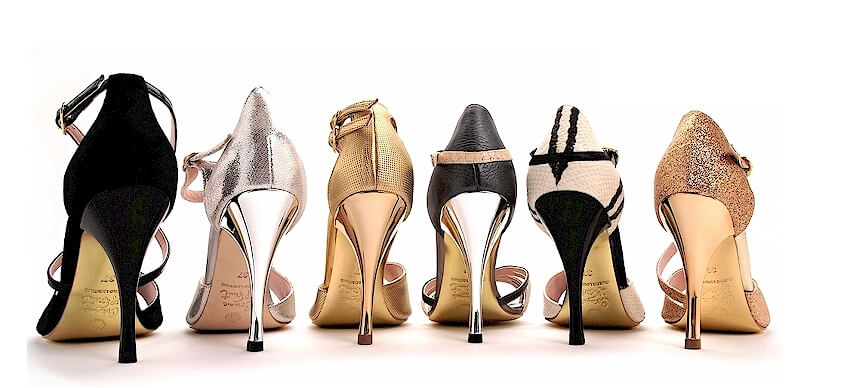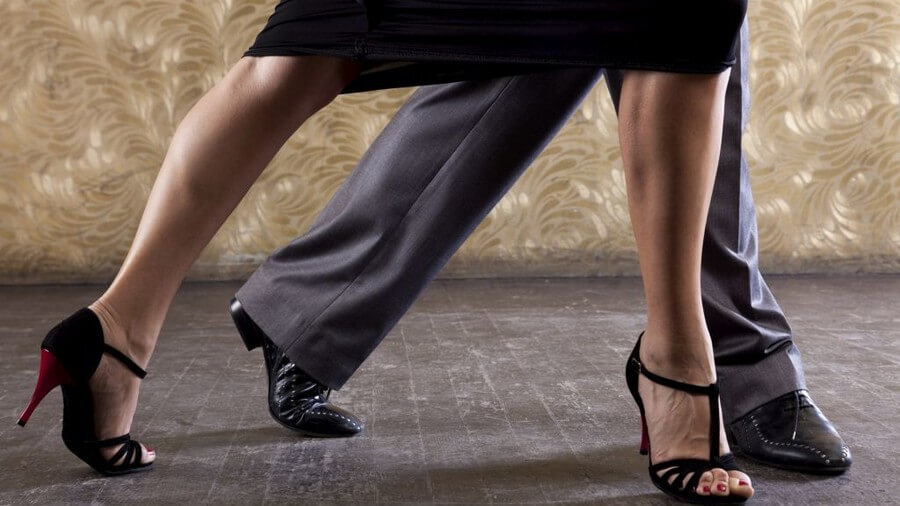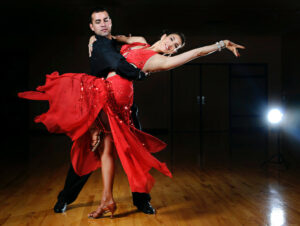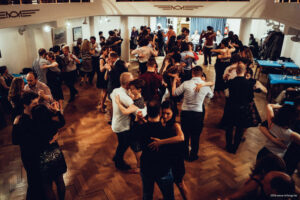First of all, an answer to the question why you should buy tango shoes. Although sneakers or city shoes are perfect for your first tango experience, it is all about the feeling when you dance. A similar story for those who kick a ball with normal city shoes: it works very well! But the result, and especially the feeling of the right footwear, is completely different. And once you’ve experienced that, you don’t want to go back to your city shoes at all. The same goes for dancing the Argentine tango in the right tango shoes.
That is why there are 5 things you should know when buying your tango shoes.
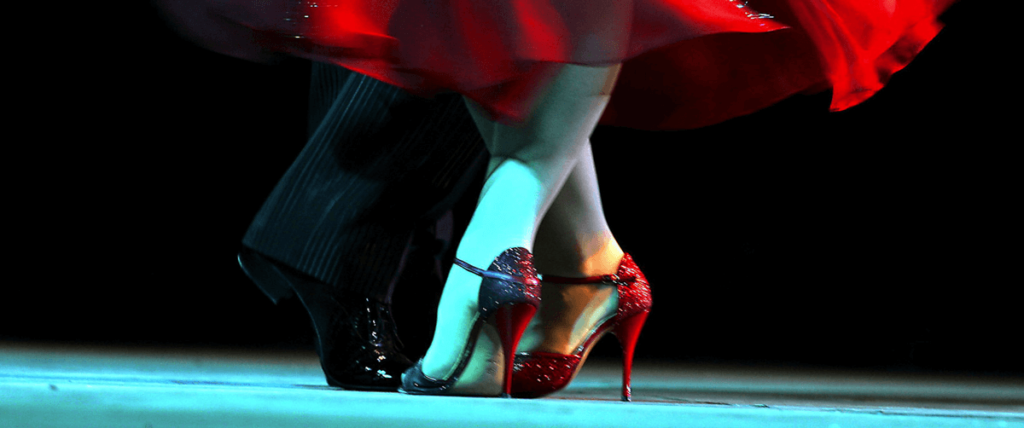
1/ DANCE SHOES ARE LIGHT AND GIVE SUPPORT
My own experience as a dancer teaches me that you save your body with the right dancing shoes. A weekday city shoe has a rubber or leather sole. Because of this rubber you stick to the floor, as it were, so your ankles and knees have to work much harder to move your feet. A leather sole on a wooden floor can become slippery when dancing. As a result, you will have to work much harder to keep yourself in balance.
Hence, the choice for appropriate tango shoes. Not only are they lighter than a regular city shoe, they also provide more support while dancing. By using the dancing shoes, you can lift and move your feet more easily. As a result, wearing them ensures that you are less likely to be injured and your ankles, hips and knees are spared.
In addition, a sole of a dance shoe is made of a special type of leather (chamois leather). This is a special material that ensures that you have sufficient grip even on a slippery floor. In addition, you can brush the material if it feels too smooth for you. Because you have more grip, you feel safer. A vicious circle that guarantees dance comfort!
2/ MORE BALANCE, DANCING ON THE BALL OF THE FOOT & HEEL HEIGHT
Balance
It goes without saying that you do not suddenly dance like a pro by wearing the right tango shoes. However, it is true that with the right dancing shoes you have more balance. The weight is better distributed over the sole, unlike a regular sneaker or city shoe. This is due to the good composition of a good tango shoe, made by a shoe manufacturer with expertise.
Heel height
Most tango shoes, and dance shoes in general, have a heel. As a result, you are automatically obliged to dance on the ball of your foot. And that in turn is good for developing good dance technique. A high heel not only looks beautiful and elegant, it is also very functional. In addition to lengthening the leg line, the high heel puts more weight on the front of the foot. As a result, it is important to have a minimum heel height so that the weight is more easily transferred to the front of the foot, but at the same time the heel can rest on the floor. You determine the heel height yourself, but a minimum heel height of 5 cm is recommended for women. 1,5 to 2 cm is a good heel height for men.

If you are no longer a beginning tango dancer, then I still have this tip for you: build up your heel height and not decrease it. Whenever you decide to buy a new pair of tango shoes but with a lower heel than the previous model, it means that you were too ambitious when purchasing your previous pair. Because no matter how beautiful you think a high heel is, you ultimately want to be able to dance easily and comfortably. In general, I would recommend that you wear a certain heel height for at least 6 months (if you dance an average of twice a week) before moving to the next heel height. I myself started at 6 cm and climbed up to 9 cm, where 8 cm is ultimately the most comfortable for me. However, when I give dance coachings, classes or workshops, and therefore dance for several hours in a row, I prefer to dance on a lower pair of tango shoes with a heel height of 4,5 cm. In this way I ensure minimal stress on my feet and joints.
Ball of the foot
Why is tango actually danced on the ball of the foot? Argentine tango is a dance in which a connection is made in a closed embrace (abrazo cerrado). The upper body of man and woman touch each other.
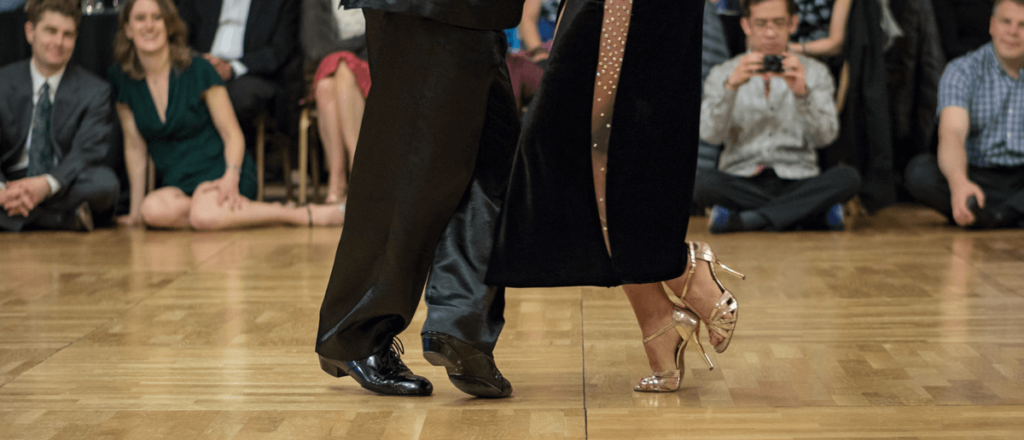
During the dancing the lady often steps backwards. As a result, the first push must come from the front of the foot so that it can shift the body weight. Compare it with ice skating. If the center of gravity is not correct or you do not use the correct posture, you will be out of balance more quickly and consequently fall. When dancing your center of gravity must also stay in the right place, otherwise you will get out of balance. Moreover, in Argentine tango pivots are often done. That also happens on the ball of the foot. That is why it is important that the center of gravity is right.And you do that by using the right tango shoes. Dance shoes with a high heel therefore ensure that the center of gravity remains in the right place during dancing. On the other hand, we do not want to say that you should only dance on your toes or the ball of your feet, because that is extremely stressful for your joints. When dancing you use your entire foot, including your heel, but the muscles in the ball of the foot will be developed the most.
3/ WOMEN'S SHOES VS. MEN'S SHOES
4/ LEATHER, SUEDE OR RUBBER
I already mentioned: in addition to chamois leather, there are also other materials for the soles of dance shoes, for example: suede, rubber or a combination.
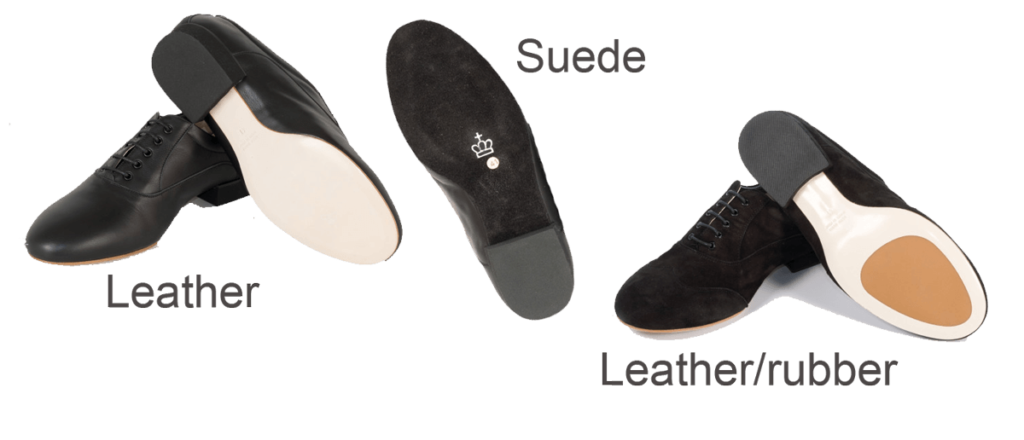
The choice of material often depends on the surface on which they will dance. The fact is that with the Argentine tango the locations can differ considerably, as a consequence the floor will never be the same type of surface. So, you sometimes dance on a wooden floor, then on marble, floor tiles or even street tiles in case milongas are organized outside.
I’ve been through each of those conditions and therefore had three pairs of tango shoes on hand each time. If the floor was a slippery wooden floor, I used my tango shoes which had a sole combination of suede and rubber. If we were lucky enough to be able to dance on a wooden dance floor, it depended on it and it could be my tango shoes with a smooth leather sole or with a suede bottom sole. The advantage of a suede sole is that you can easily scrape off the mess afterwards with a wire brush. The sole is roughened and therefore neat for the next time.
The bottom line is that you do not experience any roughness while dancing. Making rotational movements on a non-slip surface is asking for stress on the joints and you want to avoid that at all times.
5/ PURCHASE AND WHAT TO PAY ATTENTION FOR
Conclusion
If you are willing to invest in tango shoes, you will provide yourself and your body with the ideal conditions to learn how to dance the Argentine tango. Just like a football player or tennis player chooses solid material to get the best out of themselves, so by purchasing tango shoes you allow yourself a better dance technique, less injuries, stability and growth in the dance process.
